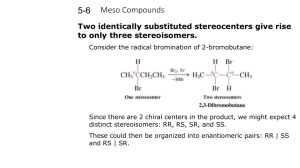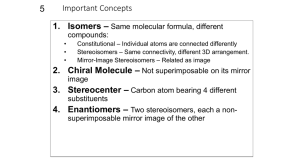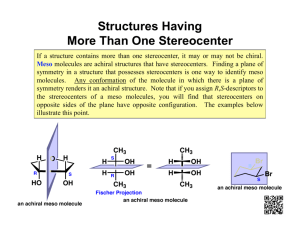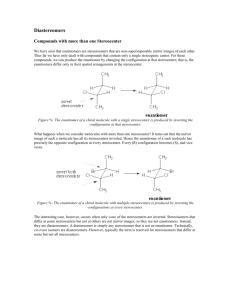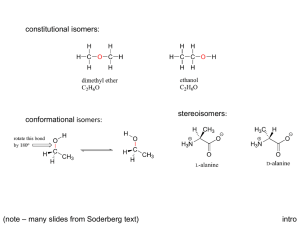Enantiomers, Diastereomers, and Meso Compounds 101
advertisement
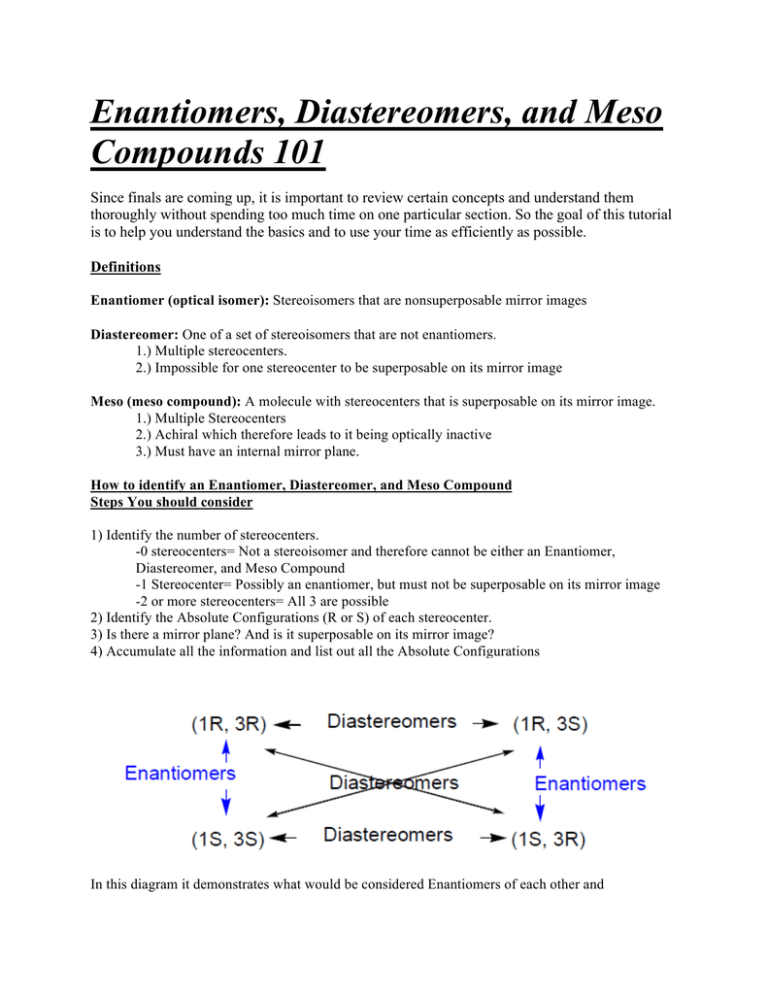
Enantiomers, Diastereomers, and Meso Compounds 101 Since finals are coming up, it is important to review certain concepts and understand them thoroughly without spending too much time on one particular section. So the goal of this tutorial is to help you understand the basics and to use your time as efficiently as possible. Definitions Enantiomer (optical isomer): Stereoisomers that are nonsuperposable mirror images Diastereomer: One of a set of stereoisomers that are not enantiomers. 1.) Multiple stereocenters. 2.) Impossible for one stereocenter to be superposable on its mirror image Meso (meso compound): A molecule with stereocenters that is superposable on its mirror image. 1.) Multiple Stereocenters 2.) Achiral which therefore leads to it being optically inactive 3.) Must have an internal mirror plane. How to identify an Enantiomer, Diastereomer, and Meso Compound Steps You should consider 1) Identify the number of stereocenters. -0 stereocenters= Not a stereoisomer and therefore cannot be either an Enantiomer, Diastereomer, and Meso Compound -1 Stereocenter= Possibly an enantiomer, but must not be superposable on its mirror image -2 or more stereocenters= All 3 are possible 2) Identify the Absolute Configurations (R or S) of each stereocenter. 3) Is there a mirror plane? And is it superposable on its mirror image? 4) Accumulate all the information and list out all the Absolute Configurations In this diagram it demonstrates what would be considered Enantiomers of each other and Diastereomers. This is also given that there is no internal mirror plane. *Note: It is important to realize the maximum number of stereoisomers possible is 2^n with n being the number of stereocenters in the molecule. Ex. 2 stereocenters will have a maximum of 2^2 = 4 stereoisomers. (RR,SS,RS, SR) *Note: This is only the maximum number of stereoisomers possible not the actual number, it may be less due to meso compounds. *Remember: In a structure with multiple stereocenters, the enantiomers have opposite configurations at all stereocenters. The diastereomers have opposite configurations at some but not all, stereocenters. EXAMPLES 1) A) Complete this statement by writing one number in each blank. Molecule C has __________ stereocenters and not including molecule C itself __________ stereoisomers. B) Draw a diastereomer of the molecule by making the least number of changes possible. In this example taken from Midterm 1 Spring 2012 Lecture 1, I have circled the stereocenters in the molecule. Now we shall denote the Red circle as 1, Blue Circle as 2, and Green Circle as 3. So at the first glance the molecule has no internal mirror plane so meso compounds are out. After looking at the molecule more closely we count the number of stereocenters to be 3. So the number of stereoisomers for this molecule is 2^3=8. The question however asks for the total number not including the molecule so the answer is 7 stereoisomers. For part B they ask to draw a diastereomer with making the least number of changes possible. Now by definition a diastereomer is any stereoisomer that is not an enantiomer. So all we have to do is make one change to the molecule to make it a diastereomer. So if we list out the Absolute configurations 1 S, 2 S, 3 S. To make a diastereomer we need to only simply invert one stereocenter (Note if we invert all then it becomes the enantiomer). 2) (a) Total number of stereoisomers (including the structure shown): ________ (b) Number of enantiomers of the structure shown: ________ (c) Number of diastereomers of the structure shown: ________ (d) Number of diastereomers of the structure shown that are also meso compounds: ________ At first glance again there is no internal mirror plane so there will be no meso compounds. Now counting the number of stereocenters in the molecule we arise to 6 stereocenters. So we use the equation 2^n with n being the number of stereocenters to calculate the number of stereoisomers. We arrive at 64 stereoisomers. Now with the given molecule above we know there is only one enantiomer to that molecule and they are enantiomers of each other. So of the 64 stereoisomers, 2 of them will be enantiomers Diastereomers by definition are stereoisomers that are not enantiomers, so 64-2=62 diastereomers. There are no meso compounds as there is no internal mirror plane so it cannot be superposable on its mirror image. 3) (2S,3R)-tartaric acid exhibits an internal mirror plane. So therefore it will form a meso compound with (2R,3S)-tartaric acid. So the equation 2^n would give us 4 stereoisomers, but due to the fact that there is an internal plane there is a meso compound which only leaves 3 stereoisomers. Works Cited http://staff.thhs.qc.edu/science/Organic_Chem/Stereochem_Primer.pdf Dr. Hardinger’s Lecture Supplement 9 edition Dr. Hardinger’s Midterm 1 Spring 2012 Lecture 1 and 2 th
